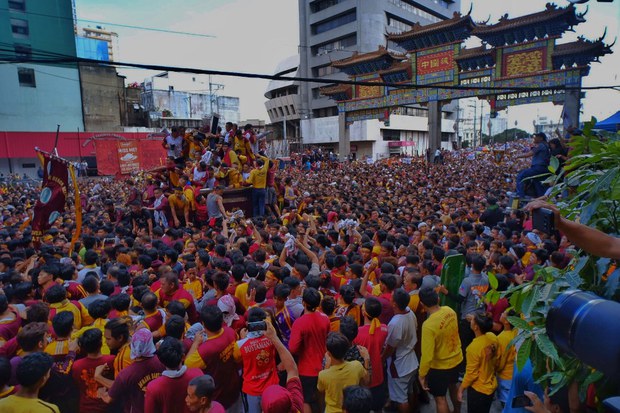Filipinos Join Crush for Manila’s Grandest Catholic Procession
2019.01.09
Manila
 Thousands watch as a crush of Catholic devotees jostles to get close to a life-sized statue of Jesus Christ with the Cross – and thought to be miraculous – as the procession for the annual feast of the Black Nazarene winds its way through central Manila, Jan. 9, 2019.
Thousands watch as a crush of Catholic devotees jostles to get close to a life-sized statue of Jesus Christ with the Cross – and thought to be miraculous – as the procession for the annual feast of the Black Nazarene winds its way through central Manila, Jan. 9, 2019.
Hundreds of thousands of barefoot Catholic devotees on Wednesday joined a frenzied Manila procession as many jostled to get near a life-sized statue of Jesus Christ with the Cross during an annual religious event in the Philippines, Asia’s only predominantly Christian nation.
Police around the Philippine capital were on a heightened state of alert amid possible terrorist threats, while schools declared a holiday for the feast of the Black Nazarene, a centuries-old blackened statue of Jesus of Nazareth that is believed to have miraculous healing powers.
Heavily armed soldiers in full battle gear were also seen patrolling the city’s streets, while coast guard vessels were on standby along Manila Bay for quick deployment.
![190109-PH-Nazarene-preparation-1000.jpeg Women devotees prepare the statue of the Black Nazarene for an annual procession in the heart of downtown Manila, Jan. 9, 2019. [Karl Romano/BenarNews]](/english/news/philippine/Black-Nazarene-01092019141506.html/190109-PH-Nazarene-preparation-1000.jpeg/@@images/7c9f3ca4-3b62-4eda-8413-cb5886ec7d61.jpeg)
Carved in Mexico in the 17th century, the Black Nazarene survived a fire that gutted the ship that brought the statue to the Philippines in 1606, when it was a Spanish colony. Devotees claim that the Nazarene’s miraculous powers rub off on the person who touches the statue or wipes it with a cloth, or that a person’s prayers are answered by completing an annual pilgrimage barefoot while accompanying the procession.
On Wednesday, devotees literally fell or piled over each other as they rushed to get near the carriage carrying the life-sized wooden statue. Medics reported that several people were injured in the procession, mostly due to fatigue.
“I come here to give my thanks. Without him, I would have been dead,” said Boks Mordeno, 66, an office employee who said he took the week off to join the festivities. He showed a scar on his chest that was left by heart bypass surgery.
![190109-PH-Nazaren-crush-1000.jpeg Filipinos shove one another as they try to get close the statue of the Black Nazarene during its procession in Manila, Jan. 9, 2019. [Luis Liwanag/BenarNews]](/english/news/philippine/Black-Nazarene-01092019141506.html/190109-PH-Nazaren-crush-1000.jpeg/@@images/3013b5c0-9593-405f-ad39-5ab9fa2d15bc.jpeg)
Mordeno said his three children had advised against him going to the procession, saying the trip would tax him physically. But he persisted.
One of his children, Byron, 23, agreed to accompany him.
The statue of the Black Nazarene is largely credited for keeping the Quiapo Church in Manila, where the annual feast around it takes place, safe through four centuries that saw the building survive fires, earthquakes and World War II that levelled most of the Philippine capital.
In 1988, the Vatican recognized the church as a minor basilica.








